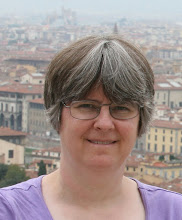Exploring fractals
I’m overwhelmed with everything I’ve been learning in Photoshop every day. I’ve been watching one lesson a day of the Adobe Photoshop CS2 Fundamental & Advanced Techniques training DVDs by Julieanne Kost, published by Software Cinema. They are excellent and are filling in a lot of the gaps in my self-taught knowledge of the program. But it feels like I’m exploring a fractal. Every time I fill in a gap with more details, I see that there’s much more in there to discover. I wanted to try to post a photo here that would illustrate how I feel about learning Photoshop, so I Googled "fractal photography" and that led me on a rabbit trail to a fun new art tool (not photographic, but what the hey) called Ultra Fractal 4. Here's my first creation with it:
The cool thing about fractals is that you can zoom in on them ad infinitum and keep seeing more and more interesting details (kind of like learning Photoshop, or learning anything about anything on the Web, or -- and here's where I get back to being relevant to my blog theme -- learning about and getting to know God). Here's another image I made of an enlargement of one portion of the above fractal:



3 comments:
How does it work? How can you zoom in ad infinitum? I don't understand that... Does the code (or whatever) you used to create it include a loop that creates something new for each zoom level? The infinite levels/images can't be physically inherent in the intial level, can they?
And another question: do fractals occur in nature? I've heard about them in, for example, map making: the cartographer has to decide to which fractal level he's going to draw the map, because there's always a further level of detail to, say, the coastline: he could show things only on a mile-by-mile scale, or he could represent each rock, or each speck of dirt.... And I understand how they work in theory, but I don't really get the physical application. Hoping for more enlightenment!
Yes, the formula for a mathematical fractal is such that when you zoom in, it gives you more and more detail, just as you get more closely approximated to the actual (infinitely repeating decimal) value of pi the farther out you compute the infinite series in Gottfried Leibniz's formula for pi:
π/4 = 1/1 - 1/3 + 1/5 - 1/7 + 1/9 = ...
(Speaking of pi, see clips from the documentary "Brain Man" about the savant Daniel Tammet who recited pi to 22,514 decimal places after memorizing them for only a few weeks; others have taken years to do such a feat.)
There are many possible formulas for fractals, and I only know the tiniest bit about fractal theory. My first fractal was based on the formula for a standard Newton fractal, which is one of the formulas provided by Ultra Fractal (I haven't yet learned enough to be able to construct my own formulas from scratch). I tweaked the parameters and the color gradient and zoomed and panned until I got a pleasing image that I liked. The result (the second of these two images) I've titled "Crabs and Eyeballs." It's amazing what variety you can get just from messing around with some exponents and such.
Oh, I forgot to answer your other question. Yes, fractals occur in nature. You mentioned the coastline application. Leaves, such as those of a fern, constitute another example (though that one was reproduced on a computer). Other examples are the veins in our body, the branching of tracheal tubes, clouds, rivers, snowflakes, etc. Here's a page of photos of fractals in nature. Here's another nature fractal gallery. And here's a vegetable called Romanesco (a cross between cauliflower and broccoli) which is incredibly fractal in nature.
Mathematics occurs all over the place in nature. The Fibonacci sequence (1, 1, 2, 3, 5, 8, ...) shows up, for example, in the spiral arrangement of scales on pine cones, seeds in a sunflower, and the Nautilus shell. There is also the related golden mean (or "golden section" or "divine proportion"), which appears in the geometry of chemical compounds and crystals, among other places. See this page and this page (note the biblical references there) and this Wikipedia article for more information.
Post a Comment